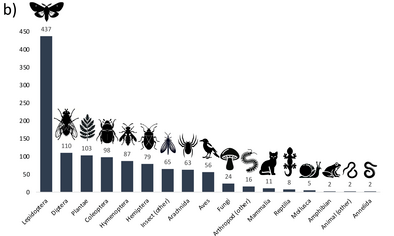An ecologist, a mathematician and a taxonomist were locked down together during the COVID pandemic.
So what's the punchline?
Yeah, no it's not the start of a silly joke! But it's how a very interesting paper came to be!
Ever wondered how many species live in the immediate area of your household? Probably not, but try to take a guess! Maybe leave it in a comment before proceeding with the rest of my post!
.
..
...
....
.....
......
.......
Ok, let's continue now.
So, the initial guess of the three researchers above and their colleagues as well, was amongst the 200–300 range. And I'd probably give a similar number.
Starting from the first day of lockdown and continuing over the course of a year, the researchers catalogued about 1,150 species, in a 430-m2 urban property and the associated three-bedroom house! And chances are there were way more that simply went unnoticed!
Here's a more detailed description of the... habitat that was examined:
The house footprint was 172 m2, with 50 m2 of open lawn area, which was largely overtaken by self-propagating weeds. The majority of the lot was shaded by large mature trees, with the understory dominated by shrubs in the front yard and various perennial weeds throughout. Some corners of the yard had accumulated small piles of wood and palm fronds. Occasionally attempts were made to garden in the corners of the yard that received sunlight, but without regular irrigation. There was no application of pesticides or herbicides or mowing for at least the preceding 4 years. source
And here's a quick graph categorizing the discovered species:
As expected, the Insecta are the clear winner..bad damn that's a lot of butterflies! And I am surprised snakes are in the bottom...considering the study took place in Australia 😄😂
The study had some pretty interesting finds. Like how for example, out of the 103 plant species reported, 100 were non-native!
Another interesting find was the small number of beetles. Just 100 beetle species winning them the fourth position. This is quite surprising since beetles are the most diverse insect group and are believed to comprise 1/3 of all insects.
They even reported three species never reported in the area before:
This included a native mosquito, Culex edwardsi (Culicidae), and the terrestrial flatworm, Platydemus manokwari (Geoplanidae), an invasive snail predator linked to numerous native snail population declines (Gerlach et al., 2021); our sighting is the southernmost record across global databases (Justine et al., 2015). These species are unlikely to be rare in Australia; rather, their lack of records indicates a vast undersampling of urban landscapes.source
Honestly it's a pretty interesting paper with equally interesting findings...And I guess I loved it because it's just a basic experiment we would all love to do. Just set out with friends and find all the different bugs and shit 😄 Too bad there are real life obligation and shit!
Here's a link to the study if you want it to give it a go. Unlike other papers I have shared this is an easy read. And here's a link summarizing the findings, written by the same authors.
Next time you think your place is boring and dull... Remember, it's probably thriving with all kinds of life!
Ok friends, this is it for today :) 😊
More Animal Stuff
If you enjoyed this post here are some other posts of mine you may like:
- The Glowing Millipede
- The dead leaf moth
- The "flies eating bird shit "-like moth
- The Ant-like Mantis
- The Moth That Mimics Jumping Spiders
- The Iron Snail
- The Snake with the Googly Eyes
- The Dead Leaf Butterfly
- The Snail Tank
- That's one epic goat
- Why These Butterflies Drink Turtle Tears
- The penguin that takes ten thousand naps..every single day
- Real life face hugger
- The Bacterium That Poops Gold !
Posted Using InLeo Alpha
